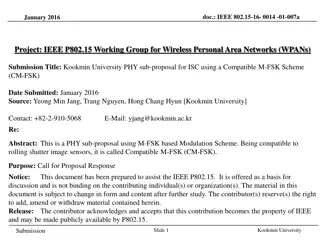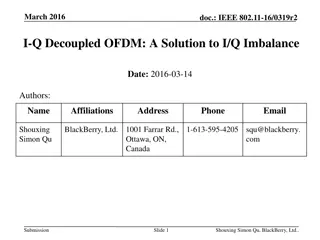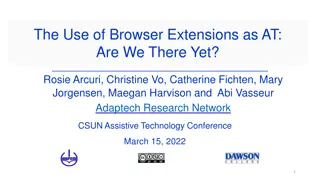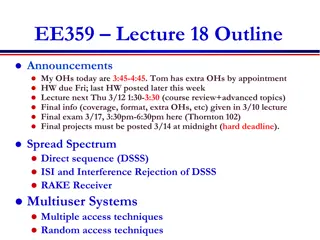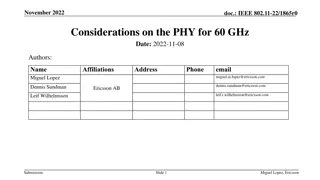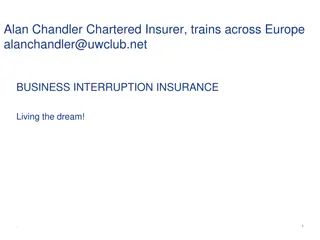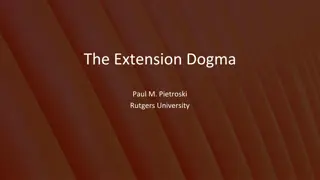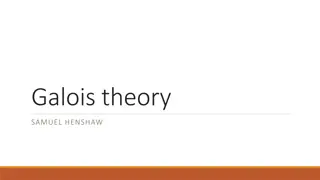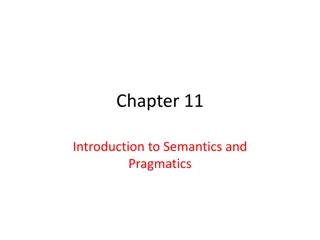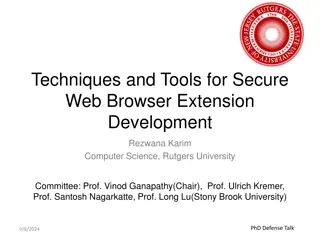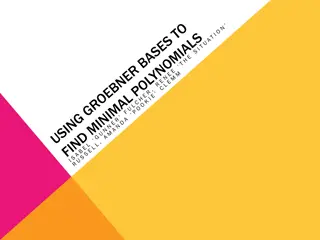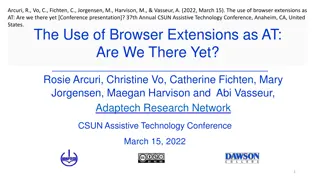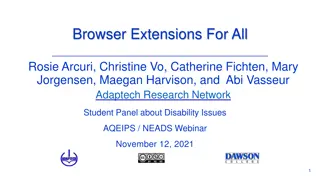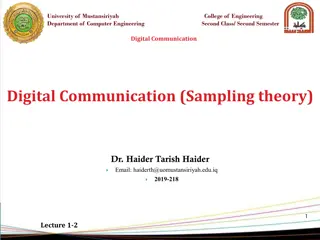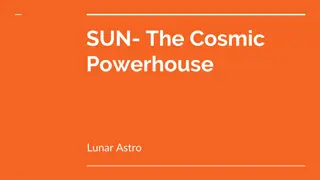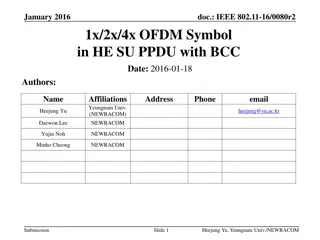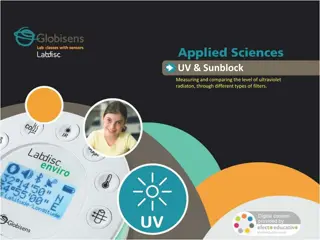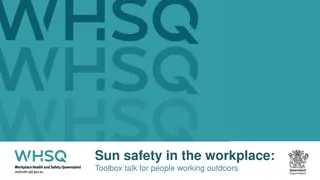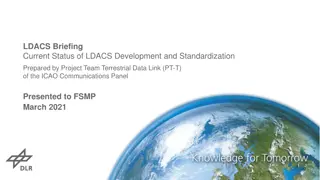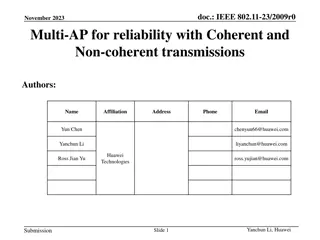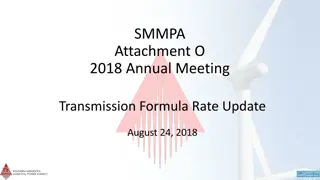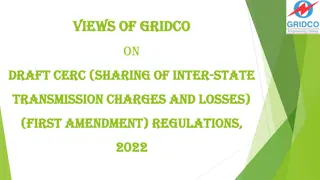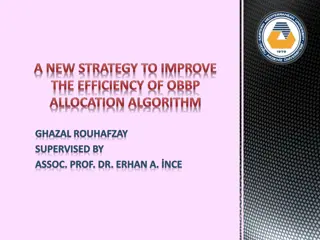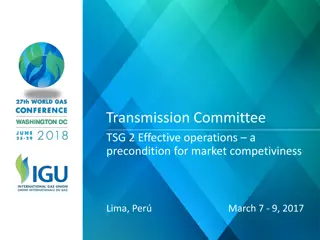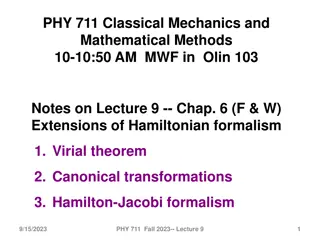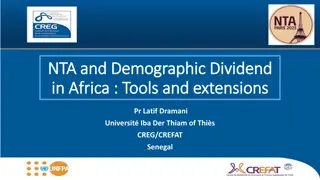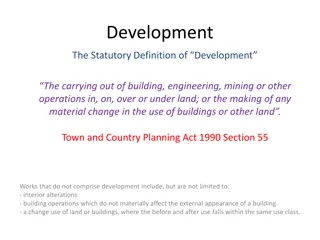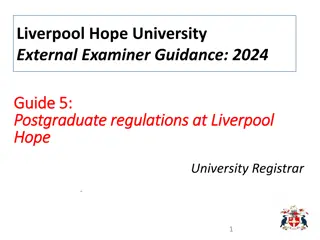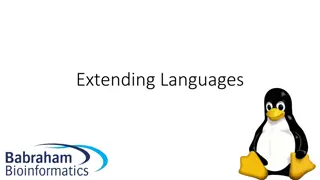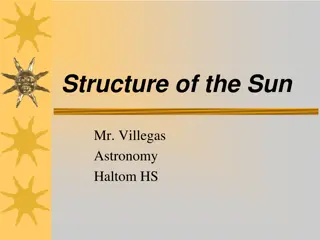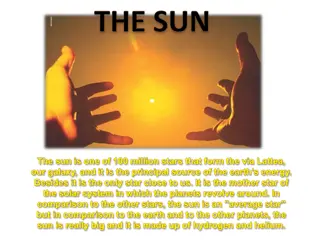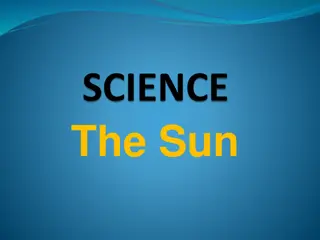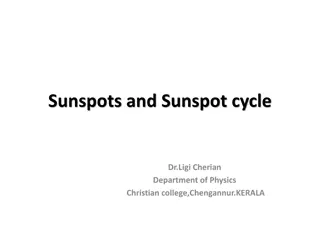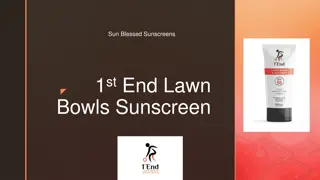Basic Transmission Characteristics of SUN-FSK and SUN-OFDM for Future Extensions
Introducing the basic transmission characteristics of IEEE 802.15.4 SUN-FSK and SUN-OFDM, deployed in various applications with improved reception schemes. The document outlines the need for future extensions in order to meet evolving usage models, applications, and bandwidth requirements, moving beyond data-centric to image and video applications in both fixed and mobile communications.
Download Presentation

Please find below an Image/Link to download the presentation.
The content on the website is provided AS IS for your information and personal use only. It may not be sold, licensed, or shared on other websites without obtaining consent from the author. Download presentation by click this link. If you encounter any issues during the download, it is possible that the publisher has removed the file from their server.
E N D
Presentation Transcript
doc.: 15-23-0390-01-04ad Project: IEEE P802.15 Working Group for Wireless Personal Area Networks (WPANs) Submission Title: [Basic transmission characteristics of SUN-FSK and SUN-OFDM and future extensions] Date Submitted: 12 July 2023 Source: Hiroshi Harada (Kyoto University) Address Yoshidahonmachi. Sakyo, Kyoto, 606-8501, Japan Voice: +81-75-753-5317 , E-Mail: hiroshi.harada@i.kyoto-u.ac.jp Re: [Wireless Next Generation, Long Range extension enhancements to 802.15.4-2020] Abstract: Introduce basic transmission characteristics of IEEE 802.15.4 SUN-FSK and SUN-OFDM and their deployment in various applications with improved reception schemes, and show items necessary for future extensions. A part of this contribution was supported from the commissioned research (No.05101) by National Institute of Information and Communications Technology (NICT) , Japan. Purpose: Provide basic information for extending SUN-FSK and SUN-OFDM Notice: discussion and is not binding on the contributing individual(s) or organization(s). The material in this document is subject to change in form and content after further study. The contributor(s) reserve(s) the right to add, amend or withdraw material contained herein. Release: The contributor acknowledges and accepts that this contribution becomes the property of IEEE and may be made publicly available by P802.15. This document has been prepared to assist the IEEE P802.15. It is offered as a basis for Submission Slide 1 H. Harada (Kyoto University)
July 2023 doc.: 15-23-0390-01-04ad Basic transmission characteristics of SUN-FSK and SUN-OFDM and future extensions July 12, 2023 Hiroshi Harada, Ph.D. Submission Slide 2 H. Harada (Kyoto University)
July 2023 doc.: 15-23-0390-01-04ad Background IEEE 802.15.4 SUN FSK is spreading around the world with smart meters and has already installed more than tens of millions of units. Many chip vendors have developed SUN FSK chips and are commercially available. Interoperability test specifications have been established by the Wi-SUN Alliance and other organizations, and certification tests are being conducted by many certification organizations. IEEE 802.15.4 SUN OFDM chips have been developed by several vendors, interoperability test specifications have been established by the Wi-SUN Alliance, and certification testing has begun. Submission Slide 3 H. Harada (Kyoto University)
July 2023 doc.: 15-23-0390-01-04ad Background Target applications have shifted from data-centric applications such as smart meters to demand for applications using still and moving images. The demand is growing not only for fixed communications, but also for mobile communications such as V2X. In Japan, the bandwidth per channel in the sub-1 GHz band has been expanded to a maximum of 4 MHz in multiples of 200 kHz. Need to expand SUN FSK and SUN OFDM to meet the requirements of new usage models (fixed, mobile), new applications (image and video), etc. Before we begin the discussion on the extensions, let s first look at the current SUN FSK and the SUN OFDM transmission characterisitics. Submission Slide 4 H. Harada (Kyoto University)
July 2023 doc.: 15-23-0390-01-04ad Expected use cases of IEEE 802.15.4 SUN Short range communications SUN Data collection base station (BS) SUN router SUN Wi-SUN radio device equipped sensor, meter and/or monitor (a) space communication Wide area open (c) Wide area mobile communication (b) Wide area urban area communication H. Harada, K. Mizutani, J. Fujiwara, K. Mochizuki, K. Obata, and R. Okumura, IEEE 802.15.4g based Wi-SUN Communication Systems, IEICE Transactions on Communications, E100-B, No. 07, pp. 1032 1043, Jul. 2017. Submission Slide 5 H. Harada (Kyoto University)
July 2023 doc.: 15-23-0390-01-04ad Expected use cases of IEEE 802.15.4 SUN Category (a) Wide area open space communication (b) Wide area urban area communication (c) Wide area mobile communication Applications Sensor, meter and/or monitor network for Energy management, Agriculture, disaster prevention, animal husbandry, and so on Information distribution, digital signage to building and store Sensing and monitoring for building and store (smart city) Sensing and monitoring from smartphone via SUN router Collection of sensing data from vehicles such as car and bus Control and management of vehicles Frequency , Typical data rate Sub-GHz bands (mainly 800-900 MHz bands), 50,100,150 kbps Transmission power AP 20 mW, 250 mW Terminal: 20 mW AP 20 mW, 250 mW Terminal, router: 20 mW AP 20 mW, 250 mW Terminal: 20 mW Antenna configuration AP TX: Compliant with regulation in each region AP RX: Multiple antennas. Diversity reception may be used. Terminal: Compliant with regulation in each region Antenna height > 4 m Coverage area 1 km-5 km 100 m-2 km 100 m-2 km Radio propagation Line-of-sight Non line-of-sight Non line-of sight Path-loss model Okumura-Hata model Walfisch-Ikegami model Walfisch-Ikegami model Fading model Multipath fading Multipath fading (e.g. GSM typical urban (TU) model) Terminal radio devices Fixed installation Basically fixed installation Installation in vehicle Vehicle speed: 40-80 km/h Multi-hop support May be needed to extend its coverage area and/or to keep high reliability. H. Harada, K. Mizutani, J. Fujiwara, K. Mochizuki, K. Obata, and R. Okumura, IEEE 802.15.4g based Wi-SUN Communication Systems, IEICE Transactions on Communications, E100-B, No. 07, pp. 1032 1043, Jul. 2017. Submission Slide 6 H. Harada (Kyoto University)
July 2023 doc.: 15-23-0390-01-04ad Specification of SUN-FSK IEEE 802.15.4-2015 IEEE 802.15.4aa Parameter #1 #2 #3 #4 #5 #6 #7 #8 #9 #10 #11 #12 Data rate (kb/s) 50 100 200 400 400 150 300 300 400 600 600 800 Modulation 2-FSK 2-FSK 2-FSK 4-FSK 4-FSK 2-FSK 2-FSK 2-FSK 2-FSK 2-FSK 4-FSK 4-FSK Modulation index 1.0 1.0 1.0 0.33 0.33 0.5 0.5 0.5 0.5 0.5 0.5 0.33 Channel spacing (KHz) 200 400 600 600 400 400 400 600 1000 1000 1000 1000 Submission Slide 7 H. Harada (Kyoto University)
July 2023 doc.: 15-23-0390-01-04ad Packet Error Rate (PER) performance of SUN-FSK Experimental transmission performance Prototype IC Lapis ML7421 Support data rates of 50 kbps ~ 600 kbps by 2-FSK Support IEEE 802.15.4-compliant FEC Certified by a certification body in Japan Meet the requirements of ARIB STD- T108 under the proposed parameters Required PER Y. Xiang, R. Okumura, K. Mizutani, H. Harada, Data Rate Enhancement of FSK Transmission Scheme for IEEE 802.15. 4- Based Field Area Network , IEEE Sensors Journal,Jan. 2021 Submission Slide 8 H. Harada (Kyoto University)
July 2023 doc.: 15-23-0390-01-04ad SUN-OFDM PHR Subcarrier modulation mapper Scrambler Puncturer PSDU Encoder Interleaver Frequency domain spreading Pilot, DC, and Guard subcarrier CP TX data IDFT Filtering insertion STF (Frequency Domain) CP: Cyclic prefix DAC: Digital-to-Analog Converter TX: Transceiver PA: Power Amplifier LTF (Frequency Domain) S. Kadoi, H. Ochiai, R. Okumura, K. Mizutani, H. Harada, IEEE 802.15. 4g/4x-based Orthogonal Frequency Division Multiplexing Transmission Scheme for Wide Area and Mobile IoT Communication Systems , IEEE Internet of Things Journal, Dec. 2021 Submission Slide 9 H. Harada (Kyoto University)
July 2023 doc.: 15-23-0390-01-04ad OFDM pilot data mapping S. Kadoi, H. Ochiai, R. Okumura, K. Mizutani, H. Harada, IEEE 802.15. 4g/4x-based Orthogonal Frequency Division Multiplexing Transmission Scheme for Wide Area and Mobile IoT Communication Systems , IEEE Internet of Things Journal, Dec. 2021 Submission Slide 10 H. Harada (Kyoto University)
July 2023 doc.: 15-23-0390-01-04ad Specification of SUN-OFDM (IEEE 802.15.4-2020) Option1 Option2 Option3 Option4 Nominal Bandwidth 1094 kHz 552 kHz 281 kHz 156 kHz Channel spacing 1200 kHz 800 kHz 400 kHz 200 kHz Subcarrier spacing 31.25/3 kHz DFT size 128 64 32 16 Number of subcarriers 104 52 26 14 Num. of pilot- subcarriers 8 4 2 2 Num. of data- subcarriers 96 48 24 12 MCS 0 MCS 1 MCS 2 MCS 3 MCS 4 MCS 5 MCS 6 Modulation BPSK BPSK QPSK QPSK QPSK 16QAM 16QAM Coding rate 1/2 1/2 1/2 1/2 3/4 1/2 3/4 Freq. repetition 4x 2x 2x 1x 1x 1x 1x Submission Slide 11 H. Harada (Kyoto University)
July 2023 doc.: 15-23-0390-01-04ad Specification of SUN-OFDM (IEEE 802.15.4-2020) Option1 Option2 Option3 Option4 MCS 0 100 kbps 50 kbps 25 kbps 12.5 kbps MCS 1 200 kbps 100 kbps 50 kbps 25 kbps MCS 2 400 kbps 200 kbps 100 kbps 50 kbps MCS 3 800 kbps 400 kbps 200 kbps 100 kbps MCS 4 1200 kbps 600 kbps 300 kbps 150 kbps MCS 5 1600 kbps 800 kbps 400 kbps 200 kbps MCS 6 2400 kbps 1200 kbps 600 kbps 300 kbps Submission Slide 12 H. Harada (Kyoto University)
July 2023 doc.: 15-23-0390-01-04ad PER performance of SUN-FSK and SUN-OFDM Compared to 100 kbps FSK, OFDM can provide about 18 dB of gain 100 Parameter Modulation scheme Carrier frequency Cyclic prefix length Value OFDM (Option 3), 2-GFSK 920MHz 1/4 (24 ms) IEEE 802.15.4g/4x OFDM Option 3 (MCS 0-6) IEEE 802.15.4g FSK AWGN Required PER AWGN, 1-path Rayleigh fading, GSM Typical Urban Channel model 10 1 0km/h in Section III 0-100km/hinSection IV PER MCS 0 (25 kbps) MCS 1 (50 kbps) MCS 2 (100 kbps) MCS 3 (200 kbps) MCS 4 (300 kbps) MCS 5 (400 kbps) MCS 6 (600 kbps) FSK (100 kbps) Moving speed PSDU length 250 octet MCS 0 6 Modulation: OFDM Decoding scheme Data rate Gaussian filter BT Preamble length Viterbi (Soft decision) 10 2 100kbps Modulation: FSK Tx: 0.5, Rx: 0.5 0 5 10 15 20 25 30 35 40 10 5 15 octet SNR (dB) S. Kadoi, H. Ochiai, R. Okumura, K. Mizutani, H. Harada, IEEE 802.15. 4g/4x-based Orthogonal Frequency Division Multiplexing Transmission Scheme for Wide Area and Mobile IoT Communication Systems , IEEE Internet of Things Journal, Dec. 2021 Submission Slide 13 H. Harada (Kyoto University)
July 2023 doc.: 15-23-0390-01-04ad Maximum transmission length to achieve required PER of 10% Data rate (kbps) Transmission distance (km) Modulation Parameters Values AWGN 1-path TU Carrier Frequency 920 MHz MCS 0 25 15.2 6.5 6.5 Bandwidth 400 kHz/channel MCS 1 50 12.8 6.0 5.6 Height 20 m Tx MCS 2 100 10.8 5.4 4.7 TX power 13 dBm OFDM MCS 3 200 9.1 4.8 3.9 Height 1.7 m Rx MCS 4 300 7.8 4.2 3.3 thermal noise power density -173 dBm/Hz MCS 5 400 6.7 3.6 3.0 Two-ray ground-reflection model Path loss model MCS 6 600 5.5 3.0 2.4 FSK 100 5.3 3.2 2.1 S. Kadoi, H. Ochiai, R. Okumura, K. Mizutani, H. Harada, IEEE 802.15. 4g/4x-based Orthogonal Frequency Division Multiplexing Transmission Scheme for Wide Area and Mobile IoT Communication Systems , IEEE Internet of Things Journal, Dec. 2021 Submission Slide 14 H. Harada (Kyoto University)
July 2023 doc.: 15-23-0390-01-04ad Improvement of channel estimation scheme Proposed channel estimation scheme 1 S. Kadoi, H. Ochiai, R. Okumura, K. Mizutani, H. Harada, IEEE 802.15. 4g/4x- based Orthogonal Frequency Division Multiplexing Transmission Scheme for Wide Area and Mobile IoT Communication Systems , IEEE Internet of Things Journal, Dec. 2021 Submission Slide 15 H. Harada (Kyoto University)
July 2023 doc.: 15-23-0390-01-04ad PER performance 100 Receive scheme Channel estimation scheme Diversity in Frequency domain remarks LE-DAC LTF only EGC PE-DAC Proposed scheme 1 EGC conventional PE-MRC Proposed scheme 1 MRC 10 1 ePE-MRC Proposed scheme 2 MRC Simulation parameters PER Parameter PSDU length Oversampling SNR (AWGN level) Channel model Carrier frequency Moving speed Modulation scheme Preamble length Data rate Modulation index Gaussian filter BT Encoding scheme Option / MCS Decoding scheme Value 250 octets 16 37.8 dB GSM Typical Urban 920 MHz 0 200 km/h 2-GFSK 15 octets 100 kbps 1.0 Tx: 0.5, Rx: 0.5 w/o FEC 3 / 2 Viterbi (Soft decision) Common 10 2 IEEE 802.15.4 FSK IEEE 802.15.4 OFDM Option3 MCS 2 LE-DAC SUN-FSK PE-DAC (Conventional) PE-MRC 10 3 SUN-OFDM 0 50 100 150 200 Moving Speed (km/h) GSM typical urban model H. Ochiai, Y. Morikawa, K. Mizutani, H. Harada, An Enhanced Channel Estimation for IEEE 802.15. 4 OFDM Receiver in High-speed Mobile IoT Communication Systems , IEEE Internet of Things Journal, Feb. 2023. Parameter Delay time ( s) Relative power (dB) Path 1 0.2 3 Path 2 0 0 Path 3 0.3 2 Path 4 1.4 6 Path 5 2.1 8 Path 6 4.8 10 Submission Slide 16 H. Harada (Kyoto University)
July 2023 doc.: 15-23-0390-01-04ad Improvement of channel estimation scheme2 Proposed channel estimation scheme 2 H. Ochiai, Y. Morikawa, K. Mizutani, H. Harada, An Enhanced Channel Estimation for IEEE 802.15. 4 OFDM Receiver in High-speed Mobile IoT Communication Systems , IEEE Internet of Things Journal, Feb. 2023. Submission Slide 17 H. Harada (Kyoto University)
July 2023 doc.: 15-23-0390-01-04ad PER performance 2 SUN OFDM has the potential to realize 200 km/h mobile communications 100 100 IEEE 802.15.4 OFDM Option3 MCS 2 PE-MRC ePE-MRC Copy-width of 1 Copy-width of 2 10 1 10 1 PER PER 10 2 10 2 IEEE 802.15.4 FSK IEEE 802.15.4 OFDM Option3 MCS 2 LE-DAC PE-DAC (Conventional) PE-MRC 10 3 10 3 0 50 100 150 200 0 50 100 150 200 Moving Speed (km/h) Moving Speed (km/h) H. Ochiai, Y. Morikawa, K. Mizutani, H. Harada, An Enhanced Channel Estimation for IEEE 802.15. 4 OFDM Receiver in High-speed Mobile IoT Communication Systems , IEEE Internet of Things Journal, Feb. 2023. Submission Slide 18 H. Harada (Kyoto University)
July 2023 doc.: 15-23-0390-01-04ad Future extension proposal SUN OFDM Consider lower transmission rates by varying the spread factor or time and frequency repetition Support up to 4 MHz/ch bandwidth Increase modulation level: 64 QAM, 256 QAM Use strong FEC: LDPC and Polar code Consider MIMO transmission SUN FSK Support up to 4 MHz/ch bandwidth Use of convolutional codes with long constraint lengths Increase interleave size to achieve mobile communications Use stronger FEC: LDPC and Polar code Submission Slide 19 H. Harada (Kyoto University)


